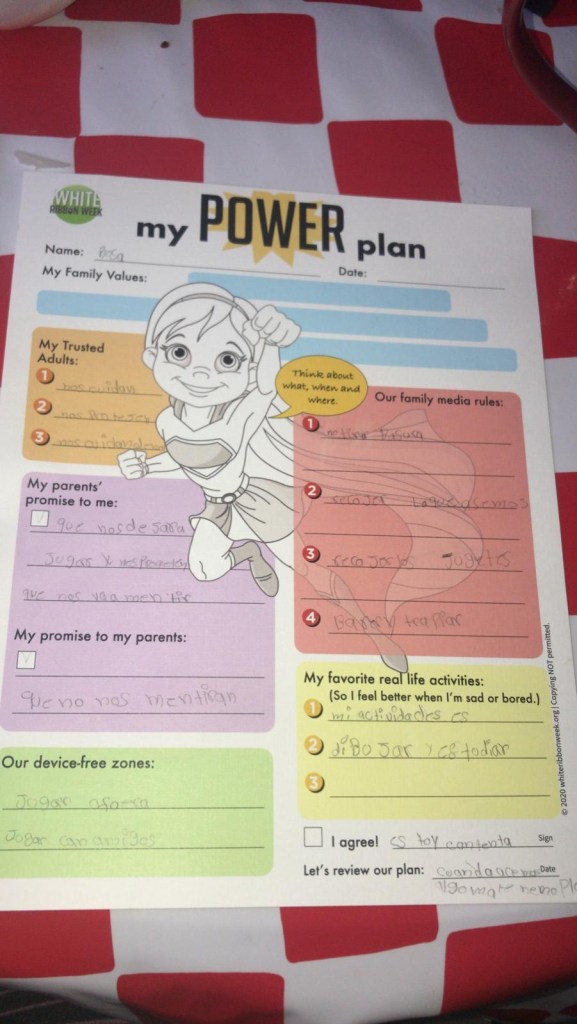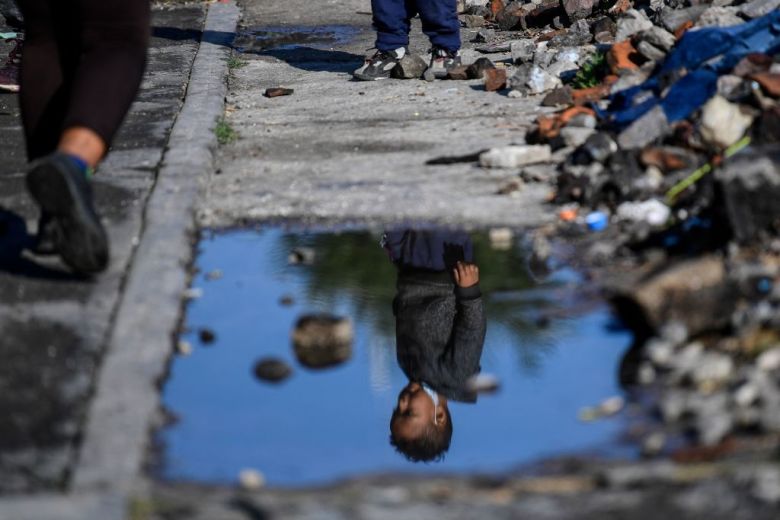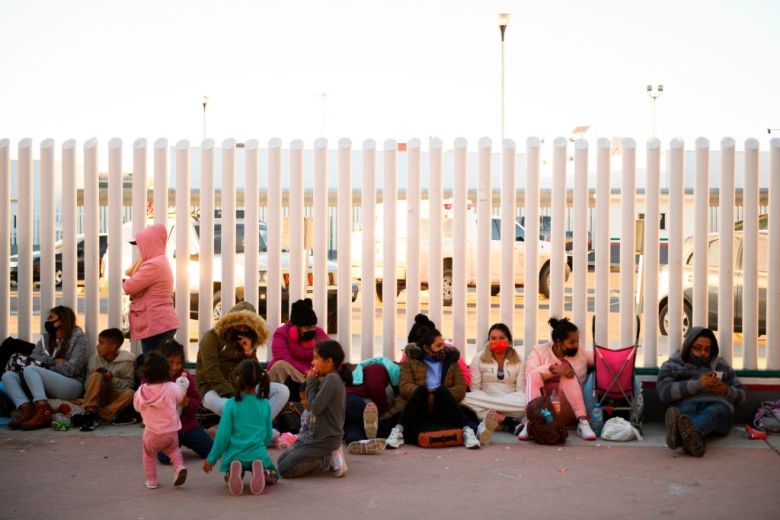In January, Rosa Bermudez brought home a colorful worksheet from Stansbury Elementary School, meant to guide her “power plan” for a safe, healthy relationship to technology.

But it was in English, and as the 11-year-old tried to fill in blank bullet points, some things got lost in translation — like when she described her family’s media rules as “picking up toys” and “sweeping and mopping.”
Just having homework is a change of pace for Rosa, who before the pandemic struck, already knew what it’s like to go without teachers or classmates for months on end. Before enrolling at schools in Utah this past winter, she and her brothers missed out on roughly two years of regular education while their family sought refuge in the United States.

Along with their parents, Sandra Vásquez and Concepción Ventura, Rosa and her brothers — Joaquín, Jeremy, Jason, and Nixon, now ages 14, 7, 6 and 2, respectively — weathered significant delays and life-threatening conditions at the southern border. Then, when they finally reached the U.S., a global public health crisis left them vulnerable, at the whim of an already unwelcoming country that was suddenly locked down and afraid.
By early 2021, they had no insurance to pay for health care, no work permits to make ends meet. Not even the assurance that they could stay.
But after just a few days back in school this winter, Rosa was already determined to study — and eventually master — the language that everyone else spoke around her. She embraced the near-constant linguistic gymnastics she had to perform, going from English to Spanish, “del inglés al español”as a bilingual friend translated their teacher’s lessons and an app helped her decipher homework.
“Here, it’s necessary to learn English,” Rosa said in Spanish.
Related: Why a Texas school district is helping immigrants facing deportation
The coronavirus pandemic has disproportionately affected immigrant students and, more generally, English learners, who have struggled with hurdles such as language barriers, subpar broadband and limited at-home learning support, according to the Migration Policy Institute.
In more normal times, “attendance is not typically an issue” among the roughly 5 million English learners in U.S. public schools, experts from MPI wrote in a September policy brief. But last spring, as physical campuses shut down because of Covid-19, many of those usually attentive students dropped off the grid at alarmingly high rates.
Meanwhile, immigrants have been ravaged by the virus globally, as they’ve endured much higher risk of infection than native-born populations while their jobs have also been decimated by the economic downturn.
And, for many asylum seekers in the U.S., the pandemic caps off a seemingly unending cycle of trauma and helplessness — first in their home countries, then in Mexico and now here.
An arduous journey
Former President Donald Trump’s administration was just starting one of its most scrutinized immigration policies — the paradoxically named “Migrant Protection Protocols,” or MPP, devised to discourage people from supposedly “taking advantage of the immigration system”— when Vásquez and Ventura’s family set out for the U.S. in January 2019.
Throughout their journey, Vásquez tried to continue educating her children, teaching them addition, subtraction, vowels, painting, and whatever else she could.

At their home in Corinto, El Salvador, the adults ran a furniture business but had been forced to pay crippling “taxes” to the gang MS-13. Relatives had been similarly extorted, and some victims of the racket had ended up dead.
To escape persecution and possible murder, Vásquez’s family decided to join her mother and her three American-citizen siblings stateside. But when they finally made it to the border after being waylaid in transit for much of the year, they were placed in MPP and sent back to Tijuana.
Known colloquially as “Remain in Mexico,” the protocols dumped people with upcoming immigration court hearings into crime-riddled Mexican cities, instead of letting them wait in the U.S. Although the Department of Homeland Security claimed Mexico would provide the migrants “with all appropriate humanitarian protections for the duration of their stay,” people in MPP were in fact largely abandoned, navigating what oftentimes turned out to be life-threatening situations with few resources.
Stranded in a foreign country, they became easy prey for cartel members and corrupt Mexican police.
Asylum seekers forced to wait in Mexico have suffered at least 1,544 incidents of rape, murder, torture or other violent attacks — including 341 kidnappings or attempted kidnappings of children, according to Human Rights First.
“People died in MPP. People were subjected to severe violence in MPP. People were trafficked from MPP,” said Alyssa Kane, managing attorney at Aldea – The People’s Justice Center, which represents migrant families.
Victims of MPP have suffered at least 1,544 incidents of rape, murder, torture or other violent attacks — including 341 kidnappings or near-kidnappings of children, according to Human Rights First.
In Ciudad Juárez, a 10-year-old girl witnessed men sexually assault and throw acid on her mother, causing second-degree burns all the way to the bone. When their family sought asylum in the U.S., they were still sent back to Mexico for months, according to BuzzFeed News.
After an 11-year-old child and his father were kidnapped and their captors threatened to harvest the little boy’s organs, the family told a reporter that they were returning to Honduras — the country they fled in the first place.
Related: After a hate crime, a town welcomes immigrants into its schools
In Tijuana, as Vásquez’s family lived first at a shelter and then in a rented room, she never left her kids alone. They spent their days inside, while they waited out five hearings. For their court date each month, the whole family presented at a U.S. port of entry around 3 a.m. and took a bus to see a U.S. immigration judge. Then, they had to turn around and go back to Mexico to wait for their next hearing.

The appearances were mostly a formality: A new, hardline transit ban that took effect nationwide in September 2019 automatically disqualified them from asylum. The executive branch had generally been reshaping U.S. immigration law and precedent to keep out people from similar backgrounds to theirs, whose homes Trump once ridiculed as “shithole countries.”
“They were crafting policy specifically to exclude people of certain nationalities, like people from Central America, people from Haiti, people from the Caribbean,” Kane said.
Vásquez and Ventura’s family was still eligible for a lesser-known, harder-to-access category called “withholding of removal,” a difficult-to-win protection that doesn’t come with the same security or pathway to permanent residence that asylum offers. It does, however, ensure that people won’t be deported to their home countries, at least for the time being. But they couldn’t afford an attorney to help them navigate the U.S.’ complex immigration system in court — a major disadvantage experienced by the lion’s share of migrants forced to wait in Mexico during their proceedings. The vast majority of people in MPP have lost their cases and been ordered to leave the U.S., Vásquez and Ventura’s family included.
Ironically, under U.S. Immigration and Customs Enforcement’s byzantine system, their family had to travel deep into the U.S. interior before they could be sent back to their home country. In March 2020, the government flew Vásquez, Ventura and their kids all the way to Berks County Residential Center, an immigration detention facility for families just over an hour outside of Philadelphia.
“One of their main goals in staying here legally, is to be able to send their kids to school.”
Alyssa Kane, managing attorney at Aldea
At Berks, some immigrants have found an invaluable resource not available to them in Mexico: lawyers. Kane’s legal team at Aldea, which represents families at Berks for free, helped Vásquez and her family file an appeal. That allowed them to stay in the U.S. while they fought their case.
With deportation temporarily off the table, immigration officials sent the family on a Greyhound bus to live in Utah, near Vásquez’s mother and siblings. Their travel itinerary was relentless, with short legs punctuated by stops that extended into the early morning, like an hour and a half layover in Pittsburgh at 2:10 a.m., and a departure from Kansas City just after midnight.
By the time they got to Salt Lake City at 10:35 p.m. on March 29, 2020, they had stopped in at least nine states during back-to-back bus rides over three days, even as life in the U.S. screeched to a halt amid the climbing death toll from Covid-19.
“Because the bus had people, I was afraid coming,” Vásquez said. But nothing happened to her family, and finally, they had arrived at their destination.
Back to school?
After three lost semesters and months spent inside, bored, amid the pandemic in the U.S., Joaquín, Rosa, Jeremy and Jason, Vásquez’s four school-aged kids, seemed to be close to returning to class.
Then, a series of obstacles knocked them even further off course last fall.
At first, with Covid-19 still ravaging the country, Vásquez preferred to have Joaquín, Rosa, Jeremy and Jason take class remotely, logging onto borrowed school computers from home with her guidance. But none of their coursework made sense.
“I didn’t know what it was saying, because it was in English,” Joaquín said.
“I couldn’t translate, help them. I couldn’t. I didn’t understand anything,” Vásquez said. “They didn’t either.”
Vásquez decided to send Rosa, Jeremy and Jason to study in-person. (Joaquín, who has aged out of elementary school, was redirected to a different campus that was too far away.) They went to class for about a month, until the family moved mid-semester. Rezoned to a new school, the children were asked about their vaccinations; they needed different shots from the ones they had received growing up in El Salvador.
From chickenpox and hepatitis A to meningococcal and Tdap, Joaquín, Rosa, Jeremy and Jason each needed multiple jabs, which cost $120 altogether. The lump sum was a big ask for their parents, who were not legally authorized to work in the U.S.
By late-2020, Vásquez had decided to wait until January to send her kids back to class. She still taught them in the meantime, as she had in Mexico.

Asylum applications have skyrocketed in recent years, and despite the constant specter of possible deportation, children like Rosa and her brothers usually want to go to public school while they await a resolution to their cases, Kane said. Parents are generally very supportive of that, too.
“One of their main goals in staying here legally, is to be able to send their kids to school, and ensure that their kids get — are able to get — a good education,” Kane said.
But the immigration detention centers that jail families often have a similar institutional feel to school campuses, setting kids up for trauma when they eventually return to a classroom setting, Kane said.
At Berks, for example, the facility grounds are eerily reminiscent of a public school, both from the outside and on the inside. Yet families aren’t allowed to leave, and they’re constantly under the control of facility employees who have infamously abused their authority, including one guard who pleaded guilty to sexually assaulting a 19-year-old detained there.
“Many children do struggle with going back into that system of having a teacher tell them what to do, and having to sit in one place for most of a day, and do what you’re told,” Kane said. “They experienced that in such a traumatic way.”
“I couldn’t translate, help them. I couldn’t. I didn’t understand anything.”
Sandra Vásquez, a mom seeking asylum with her husband and five kids
Kids who spent half a year or longer in Mexico because of MPP are also dealing with major education gaps, she said, and she expressed concerns about “how much that instability and that trauma will affect a child’s educational development later on.”
Then, a bevy of logistical obstacles — from connectivity issues to lack of space and resources at home — make accessing online education challenging for English learners as a group, despite herculean efforts by states to provide hotspots and devices.
“It is still very clear that many students are — have been — lost, that teachers are still not seeing these students engaged, or are not having regular contact with these children,” said Melissa Lazarín, senior advisor at the Migration Policy Institute. “There’s no question in my mind that these students are overrepresented in the group, in the category of students who are not getting, are not reaping the benefits of remote learning right now.”
Related: How teachers are helping students affected by deportations
In Los Angeles, for example, less than half of English learners participated in remote learning each week during the first months of the pandemic, according to an MPI report. Similar phenomena cropped up in other cities, including Sacramento and Chicago.
In the fall — the first full semester affected by Covid-19 — low grades skyrocketed among English learners in areas such as Fairfax County, Virginia, and Montgomery County, Maryland. By December, 36.1 percent of English learners in Connecticut were chronically absent.
At the Granite School District in Utah, where Vásquez’s children attend school, 609 of the district’s 16,036 English learners haven’t logged on at all to the online learning platform this spring.
“Hopefully, a president who’s coming into office espousing unity will be the one to finally unite Congress around this extremely divisive issue.”
Sarah Pierce, policy analyst at MPI
But, despite all the obstacles stacked against them, Joaquín, Rosa, Jeremy and Jason were determined to get back in class. In January, the family finally got their costly vaccines. (The district said it had informed them that immunizations were available through charitable donations.)
Soon after, the elementary-aged kids trooped to their new school, Stansbury, and Joaquín started at West Lake STEM Junior High.
In the days leading up to her return to class, Rosa was nervous.
“People speak English, and I don’t understand them,” she said.
New, cautious hope
As Vásquez’s kids geared up for a new semester at new schools, the White House was simultaneously preparing to welcome a new commander-in-chief whose radically different platform could change their family’s future.
After being sworn into office in January, President Joe Biden immediately took a sledgehammer to some of Trump’s most extreme policies, including practices that affected migrants and asylum seekers. Berks’ troubled hallways have emptied out, at least for now, and one of the Biden administration’s ambitious legislative goals is meaningful reform that re-envisions the nation’s broken immigration system, after decades of gridlock.
“Hopefully, a president who’s coming into office espousing unity will be the one to finally unite Congress around this extremely divisive issue,” said Sarah Pierce, a policy analyst at MPI. “But it definitely [is] an uphill battle.”
Biden has also promised to dismantle his predecessor’s intricate web of immigration regulations, but much of Trump’s legacy will take months if not years to undo, as changes wind through tedious red tape and get caught up in the courts.
Related: Going to school when your family is in hiding from ICE
Meanwhile, all eyes have once again turned to the U.S.-Mexico border, where a humanitarian challenge is unfolding as the new administration faces an influx of migrants, and officials are now struggling to process and care for thousands of vulnerable children and families amid the pandemic.
In March, U.S. Customs and Border Protection encountered 18,890 children traveling across the border unaccompanied by parents or guardians — a monthly record, NBC News reported.

But there’s hope at the border, too. People in MPP who still have active cases are finally entering the U.S., and the Biden administration is considering a complete overhaul of the existing defensive asylum process so it’s more efficient for future applicants.
For now, it’s still unclear what will happen to families such as Vásquez’s. They’re in a holding pattern, waiting for either an announcement from the new administration or a decision from the Supreme Court about whether MPP, now defunct, was lawful.
While they wait, they’re building a life in their new communities.
At his junior high, Joaquín’s favorite class is reading. The three younger siblings are on a waiting list for a Spanish dual-language program and are receiving English language development services in the meantime, as well as targeted instruction to help them learn the language, according to the Granite School District’s administration.
Spanish is a common language locally, and support is there for students who need help, said Charlene Lui, director of educational equity for the district. But because Vásquez’s family is new in town, they may not have known how to reach out, Lui conceded.
“We definitely need to do a better job at that,” she said, “making sure that they’re aware of the services that we have available.”
On the “power plan” worksheet, one of Rosa’s early assignments at Stansbury, she was asked to list her “favorite real life activities.” Many 11-year-olds in the U.S. might fixate on sports or sleepovers, but not her.
“Estudiar,” she wrote. To study.
This story about asylum seekers was produced by The Hechinger Report, a nonprofit, independent news organization focused on inequality and innovation in education. Sign up for Hechinger’s newsletter.



